The thin, crisp air of the Colorado Rockies had always been a double-edged sword for me. It invigorated my spirit and fueled my passion for snowboarding, and eventually splitboarding, but it also challenged my body in ways I couldn’t fully comprehend. As a seasoned athlete, I knew the importance of acclimatizing, but I’d never quite felt like my breathing was in sync with how it should be.
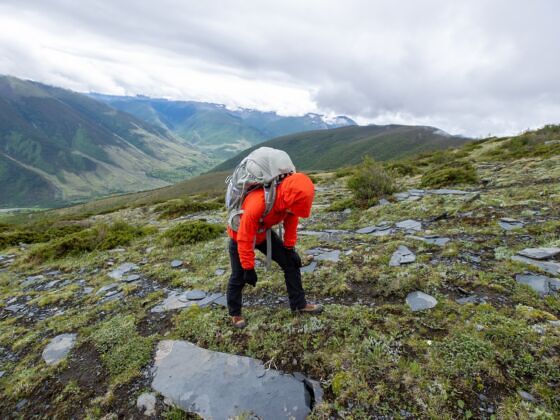

I Spent Five Weeks in a High-Intensity Breathwork Course to Perform Better at High Altitudes. Here's How It Went.
Earlier this year I received a press release from Recal Travel announcing the launch of a high-altitude breathwork training course. Intrigued by the promise of unlocking my body’s potential, I signed up. This decision would lead me on a journey of a bit of self-discovery, a lot of breathwork transformation, and a newfound appreciation for the delicate balance between mind, body, and environment.
“I want you to be able to tolerate higher levels of carbon dioxide,” Anthony Lorubbio, founder of the Recal Travel, told me on our intro call. “We want you to feel less breathless on the mountain. You’ll be oxygenating your body more with higher levels of carbon dioxide.”
That’s because of the Bohr Effect, named after Christian Bohr, a Danish biochemist who was a pioneer in respiratory physiology. This refers to how changes in pH and carbon dioxide levels in the blood affect hemoglobin’s affinity for oxygen. In essence, hemoglobin releases oxygen more readily in tissues with lower pH and higher carbon dioxide concentrations, such as actively metabolizing muscles. This mechanism is crucial for efficient oxygen delivery to tissues. When you’re headed to place without much oxygen, like the high alpine, one needs to be able to optimize this effect to their advantage.
As a dedicated splitboarder and lifelong mountain athlete, taking advantage of the Bohr Effect is something I never knew I needed to do, until I met Lorubbio. To do this, I’d need to learn to breathe more slowly. To allow the oxygen to really spend time in the body. The course is designed to build mental resilience alongside breathing techniques. For me, both were critical. I’m a disciplined person with a seemingly rigid workout routine, and who recreates in the mountains about 100 days per year. However, my mind has gotten the best of me on long days in the field before, and this is something I’ve worked to overcome over the years through mindfulness meditation, journaling, and generally trying to slow my ADHD brain by a couple notches.
I signed up for the High Altitude Breathwork Course from Lorubbio’s company, Recal Travel, to help me accomplish this. Over the course of five weeks, I’d see progress through struggle, gain through giving in, and ultimately, come out as a better athlete. Here’s how it went.
Background on Anthony Lorubbio
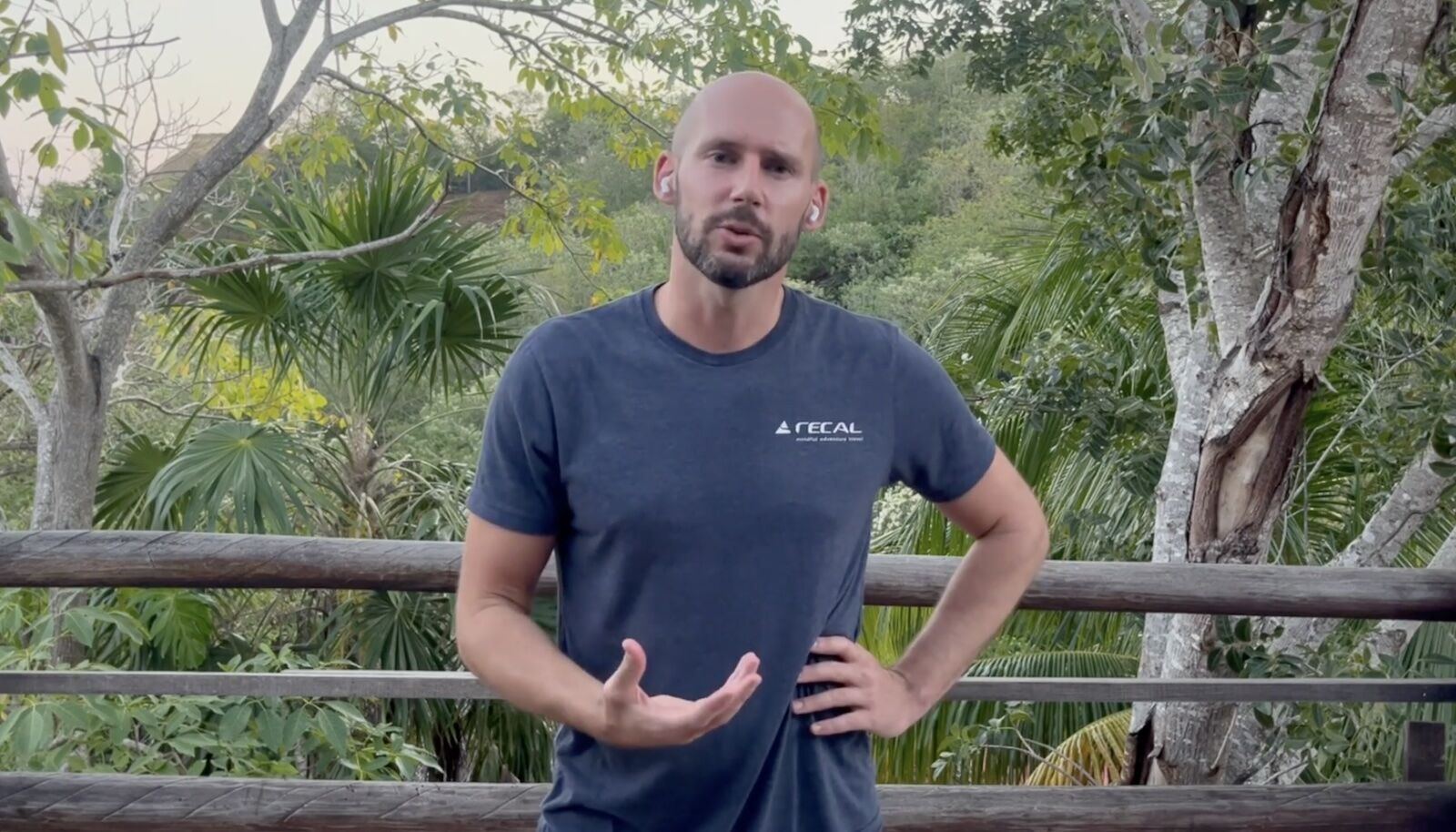
Coach Anthony walks through the exercises via video, always with a gorgeous background. Screenshot taken from Recal Travel
Anthony Lorubbio is a certified Wif Hof Method Coach and a practitioner of proper breathwork. He’s gained some acclaim for, among other things, hosting a weekly “Monday Morning Breathwork” livestream on social media. His company, Recal Travel, exists to connect travelers to nature, and it does so through trainings, trips, and resources. Recal also offers a guidebook journal for adventurers as well as a basic hiking breathwork guide, each available on its website. Lorubbio and his company specialize in mindful travel and proper preparation for high-altitude adventures.
How the Recal High Altitude Breathwork Training Course works
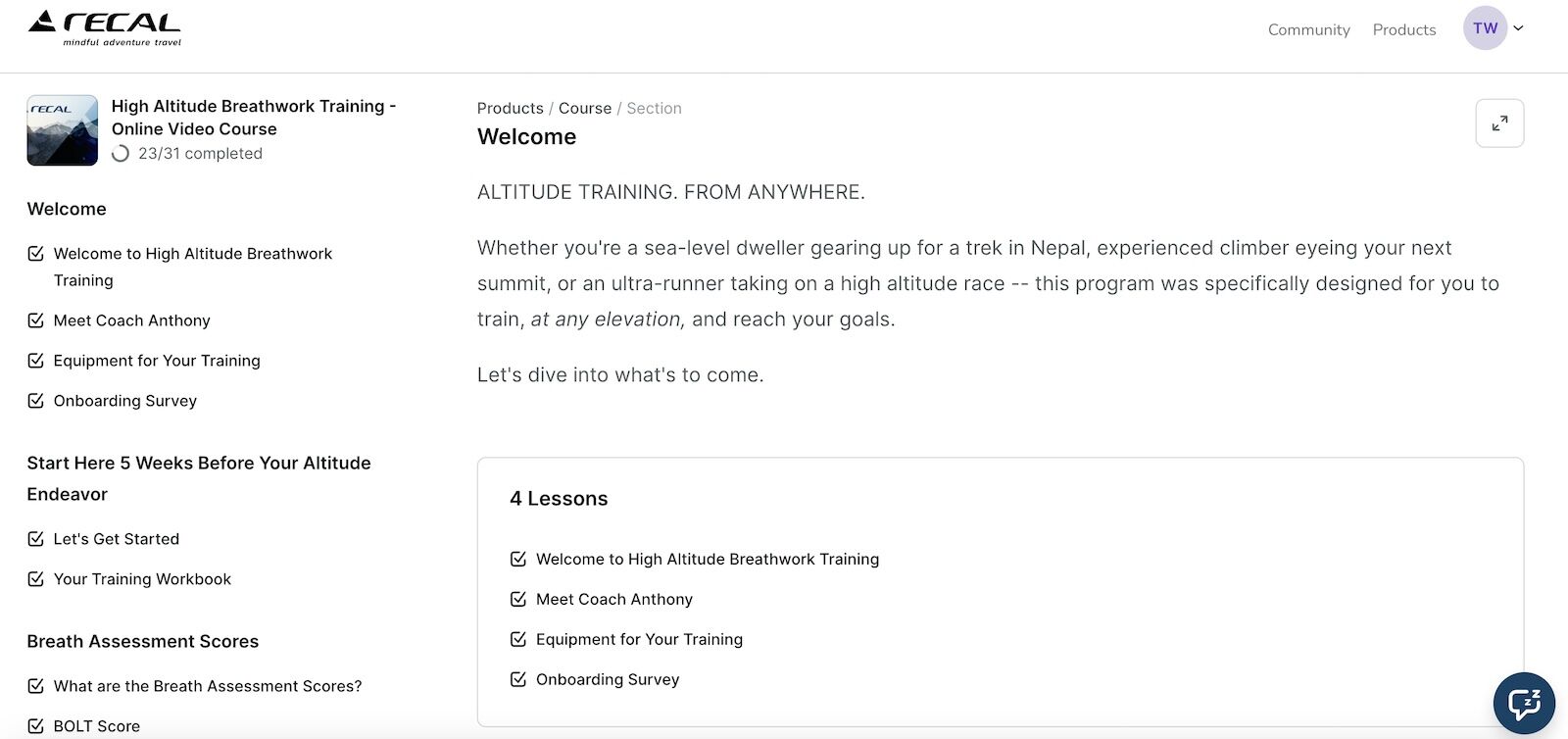
Dashboard screenshot courtesy Recal Travel
Recal offers its High Altitude Breathwork Training Course in three tiers. There’s a PDF-only version for $75, an online version with videos and other content for $275, and a personal coaching version for $875. I signed up for the online version with the videos. This included an intro call with Lorubbio to discuss my goals and answer questions. The five-week course is divided into five segments, with the first four weeks featuring different exercises that build on what was done the previous week.
Exercises require physical activity, some of which can be done on a flat surface like a sidewalk while others require stairs or, since I live in a one-floor house with no stairs, a steep nearby hiking trail. Throughout the course I spent hours worth of time on the Palisade Rim Trail located just a couple miles from my house in Palisade, Colorado.
The final week mellows out to focus strictly on mastering Wif Hof Method breathing techniques without the physically straining aspects like steep hiking or running. Lorubbio invited me to a call prior to the fifth week to do a live instruction on Wim Hof Method breathing, which I’ll get into below.
After signing up and paying I was granted access to Recal’s online portal, the hub of the course. Here I found the five-week course broken down week by week, with videos and lessons for each week. Most are hosted by Lorubbio, breaking down elements of proper breathwork, explaining the exercises, and demonstrating them. Now and then, his co-leader Jacko makes an appearance in the videos to break down a highly technical aspect of the breathwork or guide Lorubbio through a live exercise as a demo.
Each day comprises about 30 minutes of exercises and training videos. There are options to go further, but I found that about half an hour was about the minimum daily commitment to feel like I was actually putting in what needed to be done. Some days took longer, depending on how far I decided to push the low-oxygen hiking.
The High Altitude Breathwork Training Course is built on improving a person’s score on three core breathwork tests:
- BOLT, or Body Oxygen Level Test. This test requires taking a few calm breaths in a seated position, then plugging your nose and timing how long it takes before your body sends a panicked “I need to breathe” trigger, like an involuntary swallow, tensing of the neck muscles, or a contracting diaphragm. I lasted 14 seconds before starting the course, with the stated goal of the course to get me to between 25 and 30 seconds
- CO2TT, or Carbon Dioxide Tolerance Test. This test requires taking three relaxed breaths in a seated position, followed by a deep breath. At the top of the breath, you exhale as slowly as possible, for as long as possible. I hit 59 seconds before the course, with the goal to get to 80 seconds
- Maximum Breathlessness Test. This test measures the number of steps you can take during one breath hold after exhalation. I hit 41 steps before the course, with the goal to get to 80
Beyond improving the score, the goals of the course, according to Lorubbio, are:
- To develop proper breathing techniques while dealing with breathlessness, in preparation for high-altitude expeditioning
- To make adaptations to your tolerance for CO2 sensitivity and create new red blood cells
To strengthen the diaphragm
Getting started: The first two weeks of the Recal High Altitude Breathwork Training Course
The first week eased me into the exercises. I’d done my three base assessment tests. Now it was time to do the work necessary to boost those scores. Lorubbio told me during the intro call that he’d be testing a new method with me, Respiratory Muscle Training, where I’d alternate between doing the exercises outlined on the platform and a couple of additional exercises he’d send instructions for each week via email. The primary exercises during Week 1 included breath holds and what’s called “Breathe Light Meditation,” a process that involves breathing lighter than normal for several minutes in a specific manner. The Respiratory Muscle Training exercises consisted of diaphragmatic breathing practices designed to grow your ability to maintain proper breathing at high altitude, where the air is thinner.
After working through the exercises for five days, I boosted my base assessment scores to:
- BOLT: 18
- CO2TT: 1:01 (61 seconds)
- MBT: 55 steps
Week 2 ramped up the activity a bit by adding H.A.S., or High Altitude Simulation. I spent much of the week on the Palisade Rim Trail near my house, working to strengthen the diaphragm through exercises that included walking with a plugged nose and breathing light while hiking uphill.
During this second week I began to notice certain things about my breathing patterns. I’m not certain whether they’re normal or not, and perhaps they’re the result of a lifetime of poor breathing technique at altitude. But I noticed that I had an easier time plugging my nose immediately after taking a breath and then continuing to move up the trail with full lungs (but not exhaling) and a harder time plugging my nose after exhaling. I also noted in my journal that hiking uphill without breathing is, without question, hard to do.
I pushed through the struggle over five days of training. I didn’t see the progress I was hoping for this week, and while I’d like to attribute that to the fact that the week included a few particularly hectic few days of work, the actual reason is likely that I simply need to work harder.
Heading into Week 3, I’d boosted my base assessment scores to:
- BOLT: 21
- CO2TT: 1:02 (62 seconds)
- MBT: 57 steps
Getting into a rhythm: Week 3 of the Recal High Altitude Breathwork Training Course
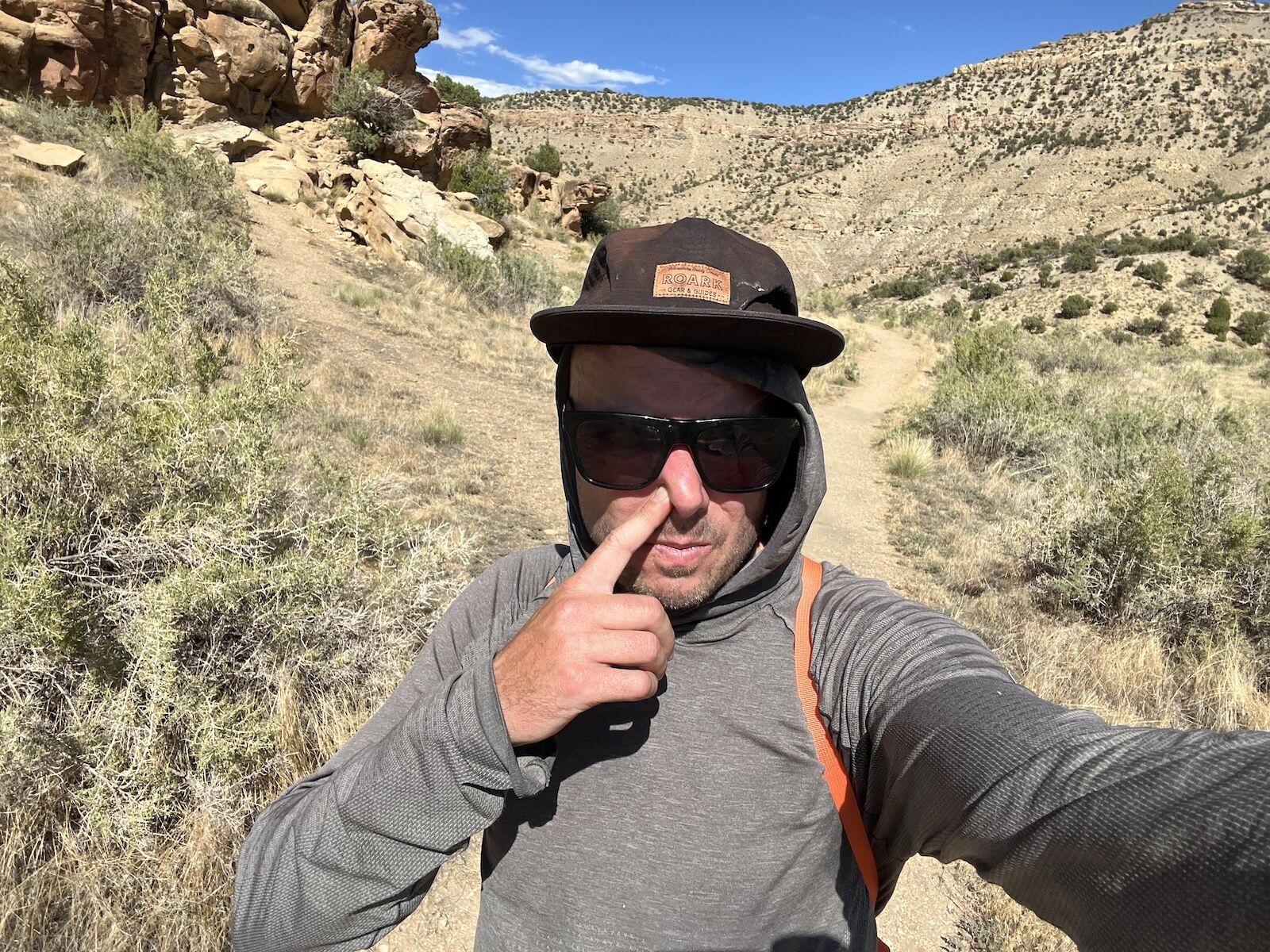
Working hard, barely breathing. Photo: Tim Wenger
Week 3 is when I really started to notice changes in my breathing. I’d by then become accustomed to having less air in my body and, somewhat counterintuitively, this began to seem normal. I felt this notably during the Rock and Roll Breathing exercise, which involved sitting cross-legged and rolling forward while exhaling to strengthen the inspiratory muscles, like the diaphragm, and expiratory muscles, like the abdomen, simultaneously. The week prior, it felt weird to breathe all the way out and then attempt to keep going. Now, it actually felt good to do so, leaning all the way forward to force out the final bits of breath through my diaphragm. I craved it. I began doing this exercise during other times of the day, for example, while watching my daughter eat a bowl of cereal in the morning I’d find myself trying to force all of the air out of my lungs. I probably looked ridiculous sitting at the kitchen table, though Olivia – typically quick to point out any irregularity that surrounds her – never said anything about it.
In the training videos for Week 3, Lorubbio notes the importance of maintaining mental composure while experiencing a lack of oxygen. The HAS bonus exercise this week, which involved briskly hiking for 20 minutes uphill with one nostril plugged, I struggled at first but after a few minutes found myself entering a “flow state” such as I’ve heard runners describe. I came to view this exercise as rather zen-like, and even enjoyable. As I moved through the training I felt this same flow pattern happen during some of the more repetitive exercises. Rock and Roll Breathing became the most impactful. I also flowed during Inverted Breathing, which required inverting myself and working through similar rapid breathing techniques.
It wasn’t all flowy goodness, though. Perhaps it was the 90-degree summer heat or the 5,000-foot elevation where I did the training, or maybe my lungs are just weak from being a smoker in my teens and early 20s. Whatever the reason, I struggled with the H.A.S. exercises that required slowly speeding up to a run while holding my breath. By Week 3 I did begin to notice small improvements day over day, but I never felt that I got close to the level Lorubbio described in the training video.
Breathe Light Meditation became the practice I felt most successful at. At first the task was awkward – breathing a short, quick breath and then exhaling it – while simultaneously trying to “clear the mind” to focus on these short breaths. I regularly practiced basic mindfulness meditation, and the shorted breathing felt counterintuitive to the long, slow breathing of the mindfulness practice. But after I became comfortable with it I was able to enter the same flow state and gain the same clarity.
Week 3 was my favorite in the course, and the point at which I made the most progress. My base assessment scores entering Week 4 were:
- BOLT: 23
- CO2TT: 1:04 (64 seconds)
- MBT: 65 steps
Closing out the course
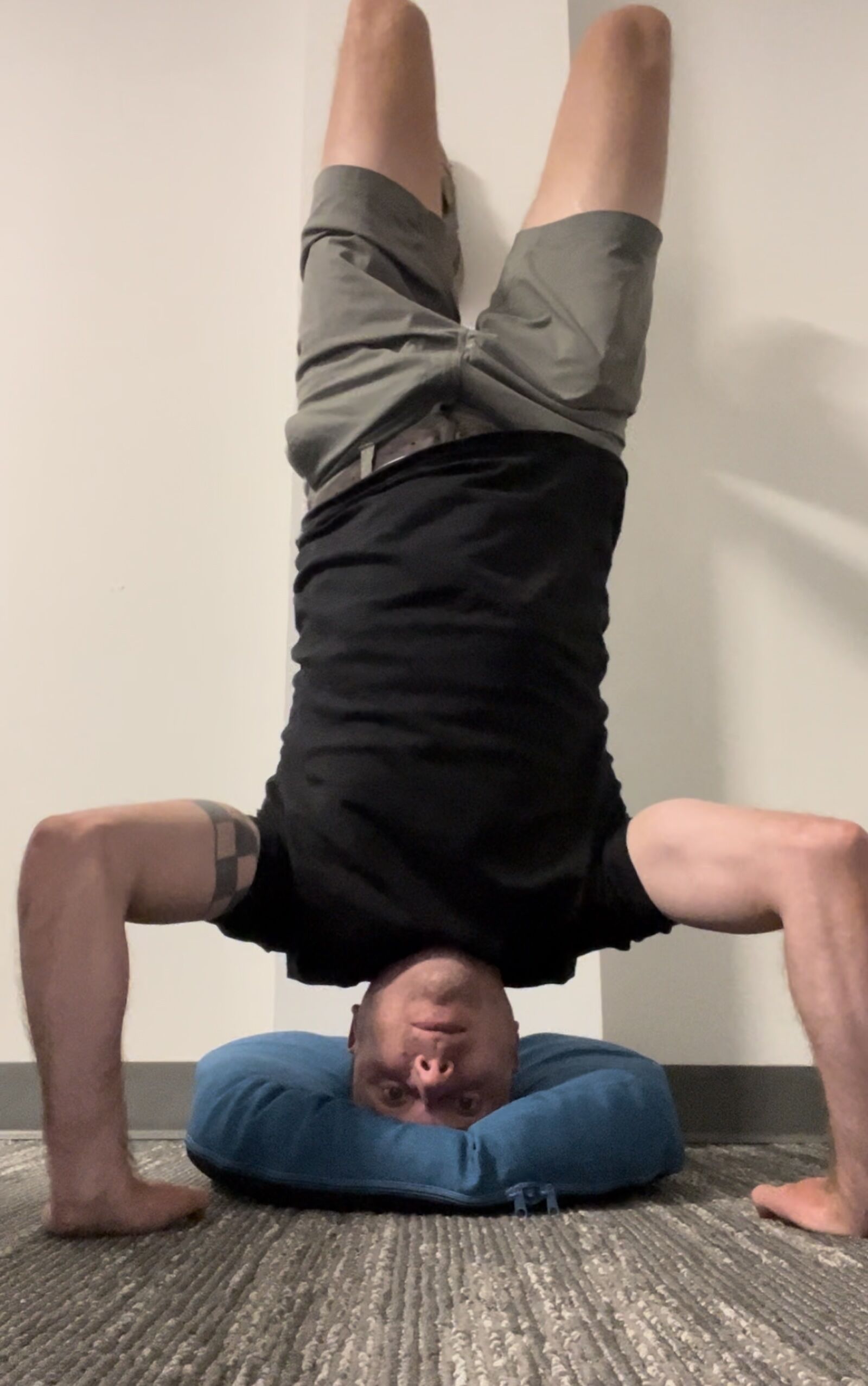
Upside down, barely breathing. Photo: Tim Wenger
On Wednesday of Week 4, I noticed a significant uptick in performance during my normal cardio workout at the gym. Where before I’d burn 13.5 to 14 calories per minute on an elliptical machine, I was consistently burning above 15 calories per minute without breathing more heavily, or seemingly exerting more effort. I also noticed that the exercises that required inhibiting my breathing resulted in cardio and stamina endurance exercises like biking and hiking, which are regular parts of my life, come easier.
Also this week I noticed my breaths had gotten considerably shorter during Breathe Light Meditation. I was better able to withstand the pain and enter the flow state. THe H.A.S. exercises this week were intense – a lot of running up the trail without breathing. I never felt great at it, but better than a couple weeks prior.
Week 5 was all about Wim Hof Method breathing. I hopped on a call with Lorubbio at the beginning of the week and he put me through a basic training. I was to do a few rounds of the method each day this week. Wim Hof Method Breathing put me into a state of calm awareness and clarity not unlike that obtained through meditation or yoga. I felt deeply engaged with the activity each day, able to disconnect even from immediate noises that surround me. I plan to work through a few rounds of Wim Hof breathing the next time I can’t sleep – rarely has an activity better calmed my mind.
I finished with base assessment scores of:
- BOLT: 26
- CO2TT 1:21 (81 seconds)
- MBT: 83 steps
So, was the Recal High Altitude Breathwork Training Course worth it?

Summit selfie. Breathing normally. Photo: Tim Wenger
As a native Coloradan, I’ve long been (foolishly) quick to dismiss concerns of altitude sickness and generally feel comfortable at altitudes up to 14,000 feet. I’ve traveled the world in pursuit of mountains, from Kyrgyzstan to Turkiye to British Columbia. But if I’m honest, working through training exercises designed to improve performance in these environments is something I should have done a long time ago. I’m a heavy breather during strenuous exercise and have never been great at holding my breath. The first victory for me in this course was accepting that I needed this training as much as anyone. The biggest difference I’ve noticed since is in how I handle stretches of time without significant oxygen.
The course taught me to push through what I previously believed to be my breaking point, and on my first long trek through the high alpine, I noticed a significant improvement in my performance. After completing the course I embarked on the Crag Crest Trail on Colorado’s Grand Mesa, an intense 10.6-mile jaunt through the alpine to a spine-like scree field that gained 1,222 feet. That’s not a significant amount of elevation gain, but the trail starts at about 10,500 feet, climbs to the top of the crest, drops down, and then gains about 500 feet more throughout the trek – you’re not done climbing until you reach the trailhead at the end of the loop. I hoped to do the trail in under four hours.
I paid particular attention to my breathing during the steepest parts of the ascent. It was less heavy than on prior endurance treks. The flow state came quicker. Looking at my trip report on Gaia GPS, I rested for only nine minutes throughout the entire hike, most of which came when I stopped to scarf down a peanut butter and jelly sandwich after descending the ridgecrest.
On a splitboard expedition in Kyrgyzstan a couple years ago, I became intimately familiar with a pounding chest each time our group stopped to catch our breath in the high alpine of the Tien Shan. I felt traces of that here, but expected it to be worse – and I fully credit a stronger diaphragm and better breathing techniques for preventing that. As an aside, though I doubt there’s science to support this, I’ve come to believe that strengthening my diaphragm, and the internal pressures required to build that strength, improved my bowel movements. I felt that exercises like Rock and Roll Breathing cleaned me out, and this certainly improved my performance in the high country.
Unless you’re wearing equipment to measure breathing and heart rate up in the high alpine, it’s tough to know, metrically, how much a training course like this boosts your performance. But you can feel the difference – I did, emphatically. The base assessment scores tell a story of vast improvement for me, and beyond those numbers, the Recal High Altitude Breathwork Training Course left me with two very stark takeaways that further justify the effort it takes. First, I found new ways to enter a flow state through proper breathing and healthy pressure on my diaphragm. This undoubtedly will stay with me forever. Second, I’ll always have these exercises to turn back to and the knowledge gained throughout the course to help me prepare for future expeditions. Bring on the mountains.